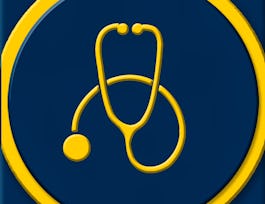This course is intended to serve as an introduction to population health from both the vantage point of both public health and healthcare. We will examine the key components of community health needs assessments, how they are used, and how to compare population health assessments across subpopulations and time. We will also explore the epidemiological sources and criteria by which to select high quality data sources to estimate population health indicators and to select evidence-based interventions to improve population health. Finally, we will design multi sector collaborations that support the phases of population health improvement.


Assessing and Improving Community Health
This course is part of The Influence of Social Determinants on Health Specialization
Taught in English
Some content may not be translated

Instructor: Sharon Kardia
2,702 already enrolled
Included with 
Course
(18 reviews)
What you'll learn
Examine the key components of community health needs assessments.
Outline a plan for population health improvement.
Understand how to select evidence-based interventions to improve population health.
Skills you'll gain
Details to know

Add to your LinkedIn profile
3 quizzes
Course
(18 reviews)
See how employees at top companies are mastering in-demand skills

Build your subject-matter expertise
- Learn new concepts from industry experts
- Gain a foundational understanding of a subject or tool
- Develop job-relevant skills with hands-on projects
- Earn a shareable career certificate


Earn a career certificate
Add this credential to your LinkedIn profile, resume, or CV
Share it on social media and in your performance review

There are 4 modules in this course
In this introduction to population health, we lay out a comprehensive definition of population health as a process and begin to describe the major approaches to population health improvement. We also outline how the “Triple Aim” of improved population health, improved patient experience, and reduced cost was woven into the U.S. Affordable Care Act through new mandates for population health practices. In healthcare settings, we describe how new patient population management and population medicine approaches are beginning to address two known areas of weaknesses - that is, gaps in care and care transitions - that can have major impacts on a population’s health. We also begin to recognize that healthcare is not designed to address root causes of disease and that new ways of thinking are needed if communities are going to have sustained improvements in their population health.
What's included
7 videos5 readings1 quiz1 discussion prompt
In this week’s module, we map the network of partnerships and interconnections that influence a population health. Specifically, we summarize the ‘health impact pyramid’ and examine connections between community health and social, economic, environmental factors. Building on this foundation, we then extend these ideas into a new arena called the ‘One Health’ concept that recognizes the interrelationship between the health of the planet, its animals, and the health of humans. To enable learners to measure the health of a community, we explore the WHO 100 health indicators and describe what makes a really good population health indicator. The ability to measure a population’s health then helps us stratify patient populations or vulnerable subgroups within a community into different risk groups who would benefit from different preventive approaches. We then end the week with an exploration of The Community Guide - a product of the Community Preventive Services Task Force - who provides systematic reviews and recommendations on the best evidence-based community health interventions.
What's included
8 videos1 reading1 quiz2 discussion prompts
The ability to measure a population’s health then helps us stratify patient populations or vulnerable subgroups within a community into different risk groups who would benefit from different preventive approaches. We then end the week with an exploration of The Community Guide - a product of the Community Preventive Services Task Force - who provides systematic reviews and recommendations on the best evidence-based community health interventions.
What's included
7 videos1 quiz2 discussion prompts
In this last week, we turn our attention to a standard way to assess and begin to plan improvements in community health - that is, the community health needs assessment. We go through the key principles and process steps underlying community health needs assessments, including some good examples. This week the final project to create a evidence-based intervention plan for your community of interest is due.
What's included
11 videos1 reading1 peer review
Instructor

Offered by
Recommended if you're interested in Public Health

University of Michigan

University of Michigan

Coursera Project Network

University of Michigan
Prepare for a degree
Taking this course by University of Michigan may provide you with a preview of the topics, materials and instructors in a related degree program which can help you decide if the topic or university is right for you.
Why people choose Coursera for their career




New to Public Health? Start here.

Open new doors with Coursera Plus
Unlimited access to 7,000+ world-class courses, hands-on projects, and job-ready certificate programs - all included in your subscription
Advance your career with an online degree
Earn a degree from world-class universities - 100% online
Join over 3,400 global companies that choose Coursera for Business
Upskill your employees to excel in the digital economy
Frequently asked questions
Access to lectures and assignments depends on your type of enrollment. If you take a course in audit mode, you will be able to see most course materials for free. To access graded assignments and to earn a Certificate, you will need to purchase the Certificate experience, during or after your audit. If you don't see the audit option:
The course may not offer an audit option. You can try a Free Trial instead, or apply for Financial Aid.
The course may offer 'Full Course, No Certificate' instead. This option lets you see all course materials, submit required assessments, and get a final grade. This also means that you will not be able to purchase a Certificate experience.
When you enroll in the course, you get access to all of the courses in the Specialization, and you earn a certificate when you complete the work. Your electronic Certificate will be added to your Accomplishments page - from there, you can print your Certificate or add it to your LinkedIn profile. If you only want to read and view the course content, you can audit the course for free.
If you subscribed, you get a 7-day free trial during which you can cancel at no penalty. After that, we don’t give refunds, but you can cancel your subscription at any time. See our full refund policy.

